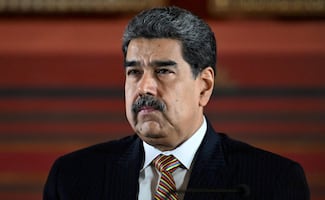Más Información

Nicolás Maduro dio pasaportes diplomáticos a narcos y facilitó aviones para lavar dinero hacia México; de esto lo acusa EU

Captura de Maduro es "un paso importante, pero no suficiente"; Edmundo González llama a una transición democrática real
Can you imagine being able to charge your cellphone or tablet with the energy of water while you take a bath ? Christian Íñiguez and Fernando Cortés , of the University CETyS campus Tijuana , are making it possible with their project RS-WC .
Together, they are working in a shower prototype with piping that connects to the toilet to save water. In this way, they intend to generate electricity, with which a cellphone, a tablet or a battery can be charged. Christian is a graduate from the first generation of the degree in Renewable Engineering and Fernando is studying C ybernetic Electronic Engineering in the same university.
The idea came up a year ago while Christian was taking a shower. “It is the moment in which the best plans come up because you think, meditate, and reflect,” he says. He noticed all the water he was wasting and thought on that amount multiplied by every person in Tijuana.
According to the World Health Organization (WHO) , a common shower lasts 10 minutes , in which 200 liters of water are used; that is, 20 liters per minute are wasted.
One of the recommendations to reduce the environmental impact caused by showers is to r educe the time to five minutes, hence only 100 liters would be used.
Christian also considered among his calculations the amount of wasted water by flushing the toilet . It was when he thought of doing something with the water wasted both during showers and flushing, a problem that, according to him, cannot continue.
After thinking of proposals, he started to draw sketches of the solutions to save water in the bathroom.
After finishing the sketches, he looked for Fernando to tell him about his idea and he loved it. Since then, they have made progress on the project every week. Together they thought of more things and opportunities to make it grow.
Then, they thought of the possibility of generating electricity with the water flow. It took them six months to complete the idea. They finished the conceptual and practical prototype for the Innovative Tijuana Environmental Fair . The event gathers projects from universities in the crossborder strip and the best ones are awarded with the idea to contribute to environmental health and promote its care.
The first edition was in 2016, in which 50 initiatives from different universities were gathered, both from Mexico and the United States .
This fair was the first time Christian and Fernando presented the practical prototype and they have made progress since then. They also participated in the Global Social Innovation Challenge competition of the University of San Diego .
This is how RS-WC works
It is made of generators , a shower , and a water pump . The generators are incorporated into one of the pieces so that it works as any shower.
Then, the water goes through the piping for its filtration ; from there, to a pump as treated water to a secondary storage that is connected to the toilet. The purpose is to reuse it for flushing the toilet and saving clean water. With a 15 minutes shower , the user would have water for five or six flushes a day.
It has caught the attention of the public and that is why they hope to obtain more capital to progress on the prototype.
“We think it’s a project that cannot wait because every time more and more water is wasted. In some years, this resource can be over and I don’t really that we are prepared as a society to face a water crisis ,” adds Christian.
“We consider it something that must be done and not only a project so that in the future we can say that this liquid is being saved. Right now, only by flushing, the equivalent of 21,000 Olympic pools is wasted in San Diego and Tijuana.” If that is multiplied for all Mexico and the U.S. the amount of waste would be gigantic.
The trials were made separately so as to measure the height of the shower and the size of a toilet . They calculated the power of the pump so that by flushing the required energy is produced.
How to take a shower and charge your phone with water?
Project RS-WC
is made by a faucet designed and printed in 3D similar to the one of a shower; the idea is to include two electric generators that work with water flow. It has an adapted circuit so that a device can connect to a USB port and charge with water-generated energy.
The first thing the user will see is the faucet to open the shower and thus start generating energy . Instead of water leaving through the drain, it will pass through a process in which soap residues and hair will be eliminated.
Once filtered and pumped, the liquid will go through a duct for its storage and reused when flushing the toilet. This process reduces the use of water while also generating energy.
A universal right in risk
In July 2010, the General Assembly of the United Nations recognized access to water as a human right . Each person must have an amount of 50 to 100 liters a day to cover his housing and personal needs.
However, water shortages affect four out of every 10 persons internationally . The problem is not only local but global.
The amount of freshwater is too little and creating drinking water from seawater would be too expensive. In the case of Tijuana, for example, they share water with San Diego that comes from the Colorado River. The water comes from Mexicali and it is transported to Tijuana, but a lternative projects have to be found.
Mexico’s National Institute of Statistics and Geography (INEGI)
reports that the Valley of Mexico has the lowest annual availability of water, as well as northern states , that receive only 25% of rainwater, in contrast to the southern border, that concentrates the biggest amount of this liquid.
During the last years, water has reduced significantly, causing drought and shortages . This is one of the scenarios that made the young Mexican students think in solutions to fight this possible water crisis that could happen in a no so far away future: approximately in five years.
According to INEGI, approximately 21.2 million homes in Mexico receive water daily, and around 1 million only receive it once a week. The lack of water faces several problems such as the overexploitation of aquifers , the distribution network , and pollution.
The cost of water varies according to the kind of use, which can be domestic, commercial, or industrial . The government built desalination plants to generate water reserves. In addition, they have noticed that an increasing number of people are not changing their habits to take care of the environment and are not changing nor adapting to the current situation.
Hence, with this project, the objective is to r educe the use of water and to recycle it , as well as the generation of electricity to charge mobile devices, and saving water at home. Until now, the project does not have any kind of economic funding to continue. Although some building companies have shown interest in the project, mainly in the U.S., there are still no investors.
From a business model, Christian and Fernando are thinking of selling it in approximately for USD $1,000 , although it is directed to building companies so that firms that build houses can buy it, therefore, it would be already included in the cost of a house and it would be part of its installation.
With RS-WC , the Christian and Fernando won the Santander Prize in the “Prototype” category, which consists of a grant of MXN $500,000 with which they will fund the project and make the necessary adjustments to finish it and sell it.
Christian and Fernando urge society to create awareness about the care of the environment and, mostly, of water.
“Buying our project guarantees being a candidate to international sustainability certifications in housing units, generating clean energy to charge a cellphone, saving water, and selling a s ustainable or renewable house ,” adds Fernando.
They assert that part of this environmental education was endorsed by their degrees, their university and even their colleagues. One of the objectives is to show that there are r ecyclable elements , such as water or organic waste.
mp
Noticias según tus intereses
[Publicidad]
[Publicidad]



















